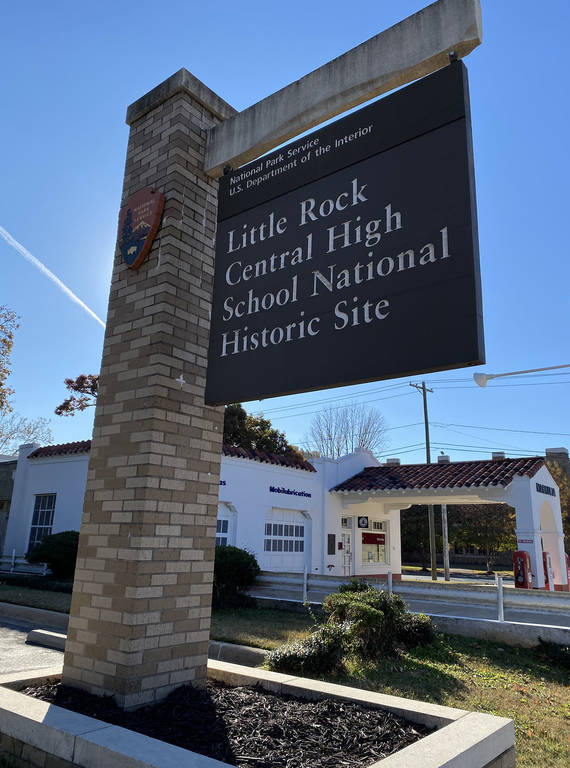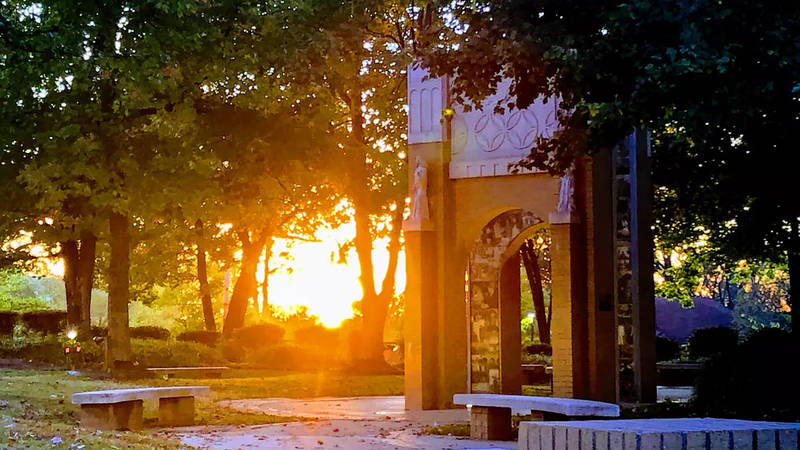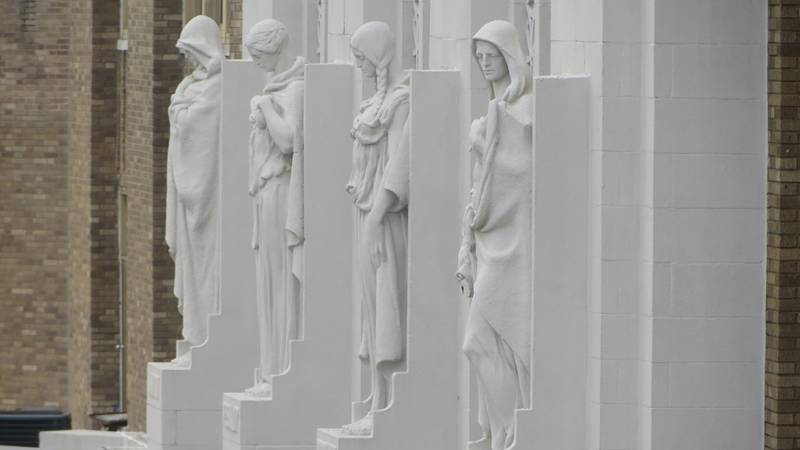“After three full days inside Central, I know that integration is a much bigger word than I thought.” — Melba Pattillo, one of the Little Rock Nine
Little Rock Central High School National Historic Site, created in 1998, preserves and interprets the story of the 1957 crisis at Central High School, where a conflicted community reacted in violent and ugly ways to U.S. Supreme Court-mandated desegregation.
An angry white mob, along with National Guard troops at the direction of Arkansas’ governor, tried to prevent nine Black students from entering the school. The U.S. president intervened with soldiers from the 101st Airborne Division, and journalists reporting through a new medium — television — brought the sights and sounds of the ensuing riots into homes across America.
Many considered the three-week event a constitutional crisis. The eventual integration affirmed the Supreme Court’s May 1954 ruling in Brown v. Board of Education and the 14th Amendment’s promise of equal protection of the laws.
Based on the National Park Service’s information and timeline of events, here are nine things you may not know about this part of America’s civil rights history.
1. The integration crisis at Central High School was the first significant test to Brown v. Board of Education.
The U.S. Supreme Court’s 1954 Brown v. Board of Education found that separate educational facilities were inherently unequal. While the decision dismantled the legal framework for racial segregation in public schools, it did not specify how or when states would integrate their schools. A series of legal maneuverings between 1954 and 1957 set the stage for the crisis.

The sign for Little Rock Central High School National Historic site, with the site’s Magnolia Mobil Gas Station in the background.
© Linda Coutant/NPCAThe Little Rock School Board adopted a six-year phased plan, but a follow-up Supreme Court ruling in 1955 defined the standard of implementation for integration as being “with all deliberate speed.” The NAACP petitioned the Little Rock School Board for immediate integration.
In January 1956, 27 Black students attempted to enroll for the second semester at Central High, Little Rock Technical High, Forest Heights Junior High and Forest Park Elementary School. They were refused enrollment by the school district, prompting a lawsuit by 12 Black parents and the NAACP.
Two months later, Arkansas’ U.S. senators and congressmen joined more than 90 other southern legislators in signing the “Southern Manifesto” — a document denouncing the U.S. Supreme Court’s decision and encouraging Southern states to resist desegregation.
In August 1956, a U.S. district court judge upheld the gradual desegregation plan, saying the school board was acting in “utmost good faith.” Despite an appeal, a federal appellate court also upheld the gradual plan, which called for integration to begin at Central High in September 1957 and other city schools to follow in subsequent years.
2. School officials vetted the Little Rock Nine before enrolling them at Central High School.
In response to Little Rock’s integration plan, principals at the city’s Black-designated junior and senior high schools informed nine students they would be enrolling at white Central High School, which was known for its academic excellence.
All nine had been vetted by school officials as living in Central’s attendance zone and having good grades. The students, ages 15-17, were Terrence Roberts, Elizabeth Eckford, Ernest Green, Thelma Mothershed, Minnijean Brown, Jefferson Thomas, Carlotta Walls, Gloria Ray and Melba Pattillo.
They were dubbed the “Little Rock Nine” by journalists, who covered the crisis that began when a white mob shouted racial slurs, threats and obscenities at the students as they walked to school.
Despite soldier escort from Sept. 25 through late October 1957, the Black students endured physical and verbal abuse inside the school building throughout the school year. Most of the nine eventually transferred to other high schools, with only three staying at Central High School until graduation. One earned her diploma through correspondence courses at Central.

The Commemorative Garden honoring the Little Rock Nine at dusk.
NPSEach of them went on to successful lives and careers, with most earning college and advanced degrees. All but Thomas, who died in 2010, are still alive.
As a reminder of their bravery, a Commemorative Garden adjacent to the school features nine benches, nine trees, concrete arches and a photographic history inlaid on brick.
3. Arkansas Gov. Orval Faubus contributed to the integration crisis.
Elected in 1954, Faubus, a Democrat, initially pursued a liberal course in office but adopted a hard line on civil rights to repel political opponents who were staunch segregationists. He insisted the U.S. Supreme Court had overstepped its constitutional authority with Brown v. Board of Education. In August 1957, he supported a petition by the Mothers’ League, a newly formed group wishing to prevent integration at Central, where some of the women had children.
On Sept. 2, one day before the start of the school year, Faubus interrupted a broadcast of the “I Love Lucy Show” on local television to announce he had received reports of “caravans” of white supremacists heading for Little Rock to prevent integration at Central High School. He would, therefore, dispatch the Arkansas National Guard to the school to prevent “blood in the streets.”
Two days later, Faubus revealed in an evening press conference that he had ordered the National Guard surrounding Central High School to block the Black students from entering — a strategy he had believed would ensure peace and order.
On Sept. 7, Faubus received a telegram from President Dwight D. Eisenhower stating in part, “the federal constitution will be upheld by me by every legal means at my command.” However, the next day Faubus re-affirmed his stance against integration in a televised press conference and insisted the federal government cease its demands for integrated schools.
4. President Dwight D. Eisenhower became the first president since Reconstruction to use federal troops to enforce civil rights.
Rather than let Gov. Orval Faubus use armed National Guardsmen to defy a U.S. Supreme Court ruling, Eisenhower federalized the Arkansas National Guard Sept. 24, 1957, and sent 1,200 soldiers from the 101st Airborne Division to Little Rock to begin escorting the students into the school.
This was the first time since the post-Civil War era that such a move had been made.
In a televised address from the White House, the president said, “Mob rule cannot be allowed to override the decisions of our courts.” The 101st Airborne Division stayed in Little Rock until November.
5. The Little Rock crisis unfolded for all to see through a new medium — TV news.
Television news was in its infancy when desegregation was underway, so the Little Rock crisis was among the first news stories filmed as events happened.
The Little Rock Nine became players in a visual public drama. Camera crews, print journalists and radio correspondents from around the country descended on the high school’s immediate neighborhood.

TV news crews gather outside Warren County High School in Front Royal, Virginia, during a school integration event in 1959.
© Thomas J. O'Halloran/Library of CongressThe Magnolia Mobil Gas Station across the street from the school became their default headquarters — in part because it had a pay telephone.
Eisenhower was moved to intervene with federal troops by the iconic images of the mob surrounding Elizabeth Eckford as she walked to school and the beating of white and Black journalists. The extensive coverage garnered by the events became a model for how the civil rights movement would use the news media over the next decade.
6. Students responded to integration at Central High School in different ways.
Despite the angry crowd, some whites welcomed the Black students. “If parents would just go home and let us alone, we’ll be all right… We can do it,” a white female student told the news media.
Soldiers escorting the Little Rock Nine inside the school documented how the Black students endured constant name-calling, kicking and tripping from their peers. White students who talked to the Black students were threatened. Bomb threats and fire drills became routine.
“The harder they fought to keep me out, the more determined I was to finish and get my diploma,” Jefferson Thomas told the news media.
Tensions erupted at times. Between December and February, several white students were suspended for violent acts against the Little Rock Nine, and Black student Minnijean Brown was suspended and later expelled for the remainder of the school year for retaliating against her aggressors.
7. Little Rock high schools were closed for the 1958-59 school year because of the 1957 chaos.
The 1958-59 school year became known as the Lost Year, because rather than find a way to peacefully integrate its public high schools after the chaotic start to integration, the Little Rock community and Gov. Orval Faubus chose to shut them down.
Despite the U.S. Supreme Court’s ruling in September 1958 that Little Rock’s desegregation plan must continue, Faubus ordered four Little Rock high schools closed as of 8 a.m. Sept. 15, pending the outcome of a public vote on integration. On Sept. 27, residents voted 19,470 to 7,561 against integration, and the high schools remained closed.
The decision left 3,665 students without access to public education. A federal court declared the closings unconstitutional, and schools reopened in August 1959. The increased level of integration in the years that followed, however, led to the start of Arkansas’s private school movement.
8. Women played key roles on both sides of the integration crisis.
The segregationist Mothers’ League formed in August 1957 and filed lawsuits to prevent integration at Central High School. Among their activities, they held a sunrise service at the school in September, singing “Dixie” and waving Confederate flags.
Those advocating for the Little Rock Nine included Daisy L. Gatson Bates, president of the state chapter of the NAACP. She led the NAACP’s protest against the school board’s plan for gradual integration, pressing instead for immediate desegregation.
During the crisis, Bates organized logistics for the Little Rock Nine’s arrival and departure from school each day, with her home as the meeting spot. The street along the high school’s north side is now named in her honor.
The Council of Church Women protested the governor’s use of the National Guard. The Women’s Emergency Committee to Open Our Schools formed a year later to publicly condemn the governor’s decision to close Little Rock high schools for the 1958-59 school year. This group also supported the reinstatement of the 44 teachers and administrators who were fired for suspected support of integration.
9. Little Rock Central High School is the only operating high school designated as a National Historic Site.
Little Rock Central High School continues to educate local youth. It enrolls more than 2,400 students.
Built in 1927, the imposing building represents a blend of art deco and Gothic revival architectural styles. Notable elements include the four Greco-Roman cast stone figures over the school’s main entrance, which represent the ideals of ambition, personality, opportunity and preparation.

Greco-Roman cast stone figures over the main entrance Little Rock Central High School represent the ideals of ambition, personality, opportunity and preparation.
NPSThe American Institute of Architecture called the building “America’s Most Beautiful High School.”
At the time of desegregation, the school served as a center of civic life and local pride, one of the reasons some people fought so fiercely against change.
Want to visit?
The 28-acre Little Rock Central High School National Historic Site is located two miles south of downtown Little Rock, the capital city of Arkansas. Its visitor center is adjacent to Little Rock Central High School, the Commemorative Garden and Magnolia Mobil Gas Station.
Stay On Top of News
Our email newsletter shares the latest on parks.
Since the high school remains operational, visitors cannot enter unless part of an organized group tour.
A short distance away are the home of Daisy Bates and a replica of the bus bench where student Elizabeth Eckford sat surrounded by the angry mob.
About the author
-
 Linda Coutant Staff Writer
Linda Coutant Staff WriterAs staff writer on the Communications team, Linda Coutant manages the Park Advocate blog and coordinates the monthly Park Notes e-newsletter distributed to NPCA’s members and supporters. She lives in Western North Carolina.
-
General
-
- NPCA Region:
- Southeast